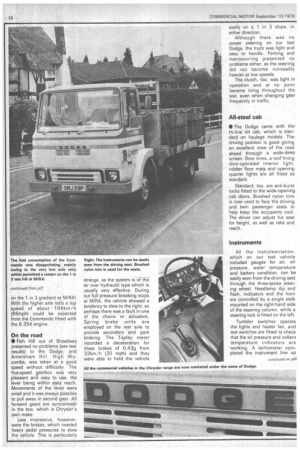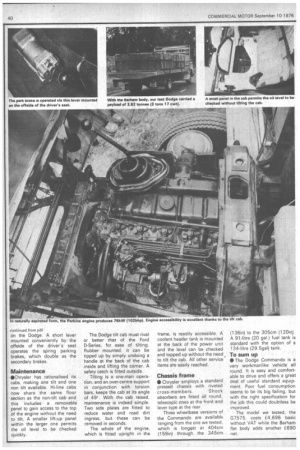Dodge Commando G08 at 75 tonnes gvw
Page 39

Page 40

Page 42

If you've noticed an error in this article please click here to report it so we can fix it.
by Stephen Gray
LIKE MOST other UK volume production truck manufacturers, Chrysler too makes a vehicle which is designed to run up to a maximum gross weight of 7.5 tonnes (7.38 tons), the Dodge Commando G08.
Although we tried a boxvan model — then known as the Commer Commando — during our group test of vehicles in this weight category (CM July 2), we have not been able to carry out a full road test of a flat-bed version with the new insignia until now.
Despite its being fitted with a five-speed gearbox, the Dodge produced disappointingly poor fuel consumption figures over our Midland test circuit. On M1 /M45 it returned 22.3 litre/100km (12.69mpg) when driven more or less constantly near its top speed of 88km /h (55mph). True, on the.
remainder of the route, traffic was very light and so a high average speed was main tained. But the Commando could not better 19.8 litre/100km :14.25mpg) from the end of the motorway through to Minster Lovell, and the consumption dropped to 21.41itre/ 100km (13.2mpg) on the final run through Hemel Hempstead.
Without doubt the low ratio of the rear axle fitted to the test vehicle was the main cause of these low figures. Our test Dodge came with a ratio of 5.14 to 1, but Chrysler says the ideal ratio for the test route would have been the optional 4.875 to 1.
Larger diameter 7.50 x 20 tyres (again optional) would have helped, too, instead of the 8.25 x 16s fitted to the truck. An operator knowing the sort of journeys he is likely to be doing, would select the ratio and tyres most suitable fo his application.
The Dodge was also fitted with the optional six-cylinder Perkins 6.354 engine, which even in its derated form as installed, gives a maximum output of 75.8kW (101.7bhp).
This compares with the output of the standard Perkins .4,236
unit which produces 57.8kW (77.5bhp). Both figures are at 2,80Orpm.
The larger engine seemingly had power to spare, pulling the Dodge along without effort. Coupled with the low axle ratio, it even allowed an easy restart on the 1 in 3 gradient at MIRA! With the higher axle ratio a top speed of about 104km /h (65mph) could be expected from the Commando fitted with the 6.354 engine.
On the road
• Fish Hill out of Broadway presented no problems (see test results) to the Dodge, and Amersham Hill, High Wycombe, was taken at a good speed without difficulty. The five-speed gearbox was very pleasant and easy to use, the lever being within easy reach. Movements of the lever were small and it was always possible to pull away in second gear. All forward gears are syncromesh in the box, Which is Chrysler's own make.
Less impressive, however, were the brakes, which needed heavy pedal pressures to slow the vehicle. This is particularly strange, as the system is of the air over hydraulic type which is usually very effective. During our full pressure breaking stops at MIRA, the vehicle showed a tendency to slew to the right, so perhaps there was a fault in one of the chains or actuators. Spring brake units are employed on the rear axle to provide secondary and park braking. The Tapley meter' recorded a deceleration for these brakes of 0.43g from 32km /h (20 mph) and they were able to hold the vehicle easily on a 1 in 3 slope, in either direction.
Although there was no power steering on our test Dodge, the truck was light and easy to handle. Parking and manoeuvring presented no problems either, as the steering did not become noticeably heavier at low speeds.
The clutch, too, was light in operation and at no point became tiring throughout the test, even when changing gear frequently in traffic.
All-steel cab
• The Dodge came with the Hi-line tilt cab, which is standard on haulage models. The driving position is good giving an excellent view of the road ahead through a wide-deep screen. Door trims, a roof lining door-operated interior light, rubber floor mats and opening quarter lights are all fitted as standard.
Standard, too, are anti-burst locks fitted to the wide-opening cab doors. Brushed nylon trim is now used to face the driving and twin passenger seats to help keep the occupants cool. The driver can adjust his seat for height, as well as rake and reach.
Instruments
All the instrumentation, which on our test vehicle included gauges for air, oil pressure, water temperature' and battery condition, can be easily seen from the driving seat through the three-spoke steering wheel. Headlamp dip and flash, indicators and the horn are controlled by a single stalk mounted on the right-hand side of the steering column, while a steering lock is fitted on the left.
Tumbler switches operate the lights and heater fan, and test switches are fitted to check that the oil pressure and collant temperature indicators are .working. A tachometer completed the instrument line up
on the Dodge. A short lever mounted conveniently by the offside of the driver's seat operates the spring parking brakes, which double as the secondary brakes.
Maintenance
"Chrysler has rationalised its cabs, making one tilt and one non tilt available. Hi-line cabs now share the same floor section as the non-tilt cab and this includes a removable panel to gain access to the top of the engine without the need to tilt. A smaller lift-up panel within the larger one permits the oil level to be checked quickly.
The Dodge tilt cab must rival or better that of the Ford D-Series, for ease of tilting. Rubber, mounted, it can be tipped up by simply undoing a handle at the back of the cab inside and lifting the corner. A safety catch is fitted outside.
Tilting is a one-man operation, and an over-centre support in conjunction with torsion bars, keeps the cab at its angle of 45°. With the cab raised, maintenance is indeed simple. Two side plates are fitted to reduce water and road dirt ingress, but these can be removed in seconds.
The whole of the engine, which is fitted upright in the
trame, is readily accessible, A. coolant header tank is mounted at the back of the power unit and the level can be checked and topped up without the need to tilt the cab. All other service items ate easily reached.
Chassis frame
• Chrysler employs a standard pressed chassis with riveted cross-members. Shock absorbers are fitted all round, telescopic ones at the front and lever type at the rear.
Three wheelbase versions of the Commando are available ranging from the one we tested, which is longest at 404cm (159in) through the 345cm (136in) to the 305cm (120in A 91-litre (20 gal.) fuel tank is standard with the option of a 134-litre (29.5gal) tank.
To sum up
• The Dodge Commando is a very workmanlike vehicle all round. It is easy and comfortable to drive and offers a great deal of useful standard equipment. Poor fuel consumption seems to be its big failing, but with the right specification for the job this could doubtless be improved.
The model we tested, the G7575, costs £4,696 basic without VAT while the Barham flat body adds another c:690 net.




























































































